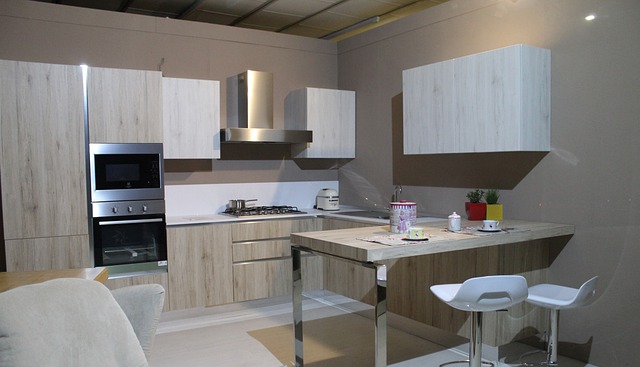When planning a kitchen remodel focused on energy efficiency, selecting the right insulation and eco-friendly materials like bamboo, cork, recycled fiber cement boards, and natural insulations is crucial. Combining this with low-energy LED lighting and energy-saving appliances significantly improves energy performance, reduces utility bills, and minimizes your carbon footprint. A sustainable kitchen renovation not only creates a comfortable cooking environment but also makes your kitchen a model for responsible living in the modern world.
Looking to transform your kitchen into an energy-efficient oasis? This comprehensive guide is your roadmap for a sustainable kitchen remodel. Discover the numerous benefits of selecting energy-efficient insulation for walls and floors, crucial components in any kitchen remodel for energy efficiency. Explore eco-friendly options, learn how to integrate energy-saving appliances, and unlock the potential of low-energy lighting for a green kitchen renovation that cuts down on your energy bills.
Understanding Energy-Efficient Insulation: Benefits for Your Kitchen
When considering a kitchen remodel for energy efficiency, selecting energy-efficient insulation is a crucial step in creating an eco-friendly kitchen. This type of insulation plays a significant role in enhancing the overall energy performance of your space. By choosing materials designed to minimize heat transfer, you can significantly reduce energy consumption associated with heating and cooling your kitchen. Benefits extend beyond energy savings; proper insulation also contributes to a more comfortable cooking environment by maintaining consistent temperatures.
An energy-efficient kitchen design often incorporates sustainable kitchen upgrades like low-energy lighting for kitchens. When paired with the right insulation, these eco-friendly kitchen renovations can lead to substantial long-term savings on your utility bills. Whether you’re planning a green kitchen remodeling project or simply looking to upgrade, prioritizing energy-saving kitchen appliances and efficient insulation is key to creating a space that’s both environmentally conscious and cost-effective.
Choosing the Right Materials: Eco-Friendly Options for Walls and Floors
When considering a kitchen remodel aimed at increasing energy efficiency, the choice of materials plays a pivotal role. Opting for eco-friendly options not only reduces your carbon footprint but also contributes to a healthier living space. For walls, materials like recycled fiber cement boards or natural insulations made from wool or cellulose offer exceptional thermal performance while being environmentally sustainable. These choices are particularly beneficial in achieving energy-efficient kitchen design, as they help maintain optimal temperatures, thereby reducing the need for excessive heating or cooling.
In terms of floors, going green doesn’t have to mean sacrificing style. Bamboo and cork are excellent eco-friendly alternatives known for their durability and unique aesthetics. They provide excellent insulation properties while being renewable resources. Additionally, integrating low-energy lighting solutions such as LED fixtures can significantly enhance the energy savings of your sustainable kitchen renovation. These upgrades not only promote a greener lifestyle but also align perfectly with the trend of green kitchen remodeling, ensuring that your home stays comfortable and stylish without compromising on environmental consciousness.
Integrating Energy-Saving Appliances with Efficient Insulation
When considering a kitchen remodel focused on energy efficiency, it’s essential to integrate both efficient insulation and energy-saving appliances. Start by selecting insulation that minimizes heat transfer, such as high-R-value foam or fiberglass, to ensure your kitchen stays cool in summer and warm in winter with minimal effort from your HVAC system. This foundation of effective insulation allows you to maximize the benefits of eco-friendly kitchen upgrades like energy-saving kitchen appliances and low-energy lighting for kitchens.
During your sustainable kitchen renovation, choose appliances labeled as energy-efficient. These models consume less power, reducing electricity bills and your carbon footprint. Pairing these with well-insulated walls and floors creates a harmonious green kitchen remodeling environment where every component works together to deliver optimal comfort while minimizing energy consumption.
Lighting Up Your Green Kitchen: Low-Energy Alternatives
When undertaking a kitchen remodel for energy efficiency, one often overlooked area is lighting. However, low-energy lighting for kitchens is a significant eco-friendly kitchen upgrade that can dramatically reduce your carbon footprint. Replacing traditional incandescent bulbs with LED lights offers an excellent opportunity to embrace sustainable kitchen design. LED technology consumes significantly less electricity and has a longer lifespan, making it a wise investment for your green kitchen renovation.
In terms of energy-saving kitchen appliances, modern options are designed not only to be more efficient but also to integrate seamlessly with low-energy lighting. From smart refrigerators that monitor and optimize energy use to energy-efficient dishwashers, these appliances contribute to an overall more sustainable kitchen environment. Incorporating such innovations during your next renovation project can ensure a comfortable, aesthetically pleasing space while minimizing the environmental impact of your kitchen remodel for energy efficiency.
The Impact of Sustainable Renovation on Your Energy Bills
A sustainable kitchen renovation isn’t just about aesthetics; it’s a powerful tool to significantly reduce your energy bills. By incorporating energy-efficient insulation and eco-friendly upgrades, like low-energy lighting for kitchens and energy-saving kitchen appliances, you’re making a strategic investment in your home’s future. These changes create a more comfortable living environment while minimizing your carbon footprint, ensuring that your kitchen not only serves as the heart of your home but also contributes to its overall sustainability.
Imagine cutting down on utility expenses, especially during warmer months when air conditioning becomes a necessity. Energy-efficient kitchen design focuses on natural lighting and proper insulation, which can drastically reduce energy usage. These simple yet effective measures don’t just save money; they promote a greener lifestyle, making your home an example of responsible living in the modern world.
When tackling a kitchen remodel aimed at energy efficiency, integrating energy-efficient insulation with eco-friendly materials and energy-saving appliances is key. This not only reduces your environmental footprint but also translates to significant savings on energy bills over time. A sustainable kitchen renovation involves thoughtful choices like selecting low-energy lighting alternatives and utilizing natural resources whenever possible. By embracing these strategies, you’re not just enhancing the comfort of your space, but also contributing to a greener world.
